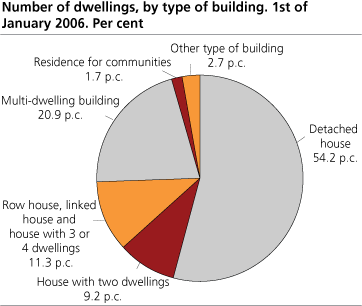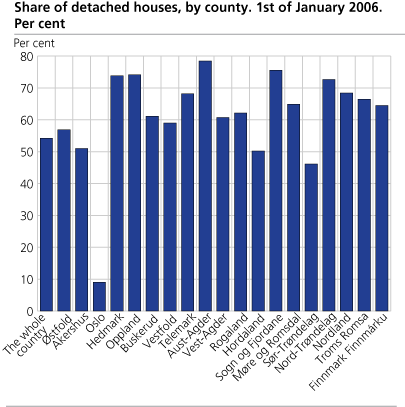Content
Published:
This is an archived release.
Half of the dwellings are detached houses
On 1 January this year 2.2 million dwellings were registered in Norway, according to new statistics from Statistics Norway. Detached houses are most common, with 1.2 million dwellings. More than 460 000 dwellings are registered in multi-dwelling buildings.
In addition, a total of 250 000 dwellings are registered in row houses, linked houses and houses with 3 or 4 dwellings, 203 000 dwellings in houses with two dwellings and 37 000 dwellings in residence for communities. Nearly 60 000 dwellings are registered in buildings where the main part of the floor space is used for other purposes than dwellings, mainly industrial buildings.
Both apartments and bed-sits are counted as dwellings. For the time being, the statistics does not distinguish between occupied and vacant dwellings, and therefore include all dwellings registered as active in the Ground Property, Address and Building Register (GAB).
Two of three dwellings in Oslo in multi-dwelling buildings
The statistics shows that over 292 000 dwellings are registered in Oslo at the 1st of January this year. Of these, almost 210 000, or 71.8 per cent, are in multi-dwelling buildings with 5 or more dwellings. Only 9.0 per cent of the dwellings in Oslo are in detached houses. Detached house is the dominating building type in all other counties. The lowest share of detached houses is found in Sør-Trøndelag with 46.1 per cent, while Aust-Agder has the highest share with 78.4 per cent detached houses.
Rogaland and Akershus has the youngest dwelling stock
Almost 693 000 dwellings, or 31.3 per cent of the total dwelling stock, are registered in buildings built after 1980. For dwellings in buildings built before 1980, the distribution on year of construction is uncertain. This is because Statistics Norway does not have information about year of construction for 11.1 per cent of the dwellings. These are mainly dwellings built before the GAB-register was established in 1983. Of the 210 000 dwellings in Akershus and 176 300 dwellings in Rogaland, respectively 38.8 and 39.0 per cent are in dwellings built after 1980. These two counties also have the largest share of buildings built after the millennium. In Rogaland, 8.8 per cent of the dwelling stock is in buildings built in the period from 2001 to 2005, while the corresponding share in Akershus is 8.2 per cent.
Oslo has the lowest share of dwellings in buildings built in the period from 1981 to 2005. Only 25.5 per cent, or 74 600 dwellings, are in buildings constructed after 1980. In Oslo, year of construction is known for almost all dwellings.
|
Comparability with the Housing Census in 2001
The register based dwelling statistics can not be compared directly with the Housing Census in 2001 . The Housing Census covered 1.96 million occupied dwellings, while the register based dwelling statistics include all dwellings, both occupied and vacant.
Extension of the statistics
During the first half of 2007 we will publish figures of the dwelling stock at the 1st of January 2007. The statistics will then be extended with information about the living standard in Norway, such as size (utility floor space and number of rooms) and information about bathrooms, water closets and kitchen. In the future it is also the plan to distinguish between occupied and vacant dwellings. More about comparability, quality and other information can be found in “ About the statistics ”. |
Tables:
- Table 1 Number of dwellings, by type of building and county. 1 January 2006
- Table 2 Number of dwellings, by type of building, county and municipality. 1 January 2006
- Table 3 Number of dwellings, by type of building and year of construction. 1 January 2006
- Table 4 Number of dwellings, by year of construction and county. 1 January 2006
Contact
-
Jens Mathiesen
E-mail: jens.mathiesen@ssb.no
tel.: (+47) 40 81 13 98
-
Mona Takle
E-mail: mona.takle@ssb.no
tel.: (+47) 40 81 14 12


